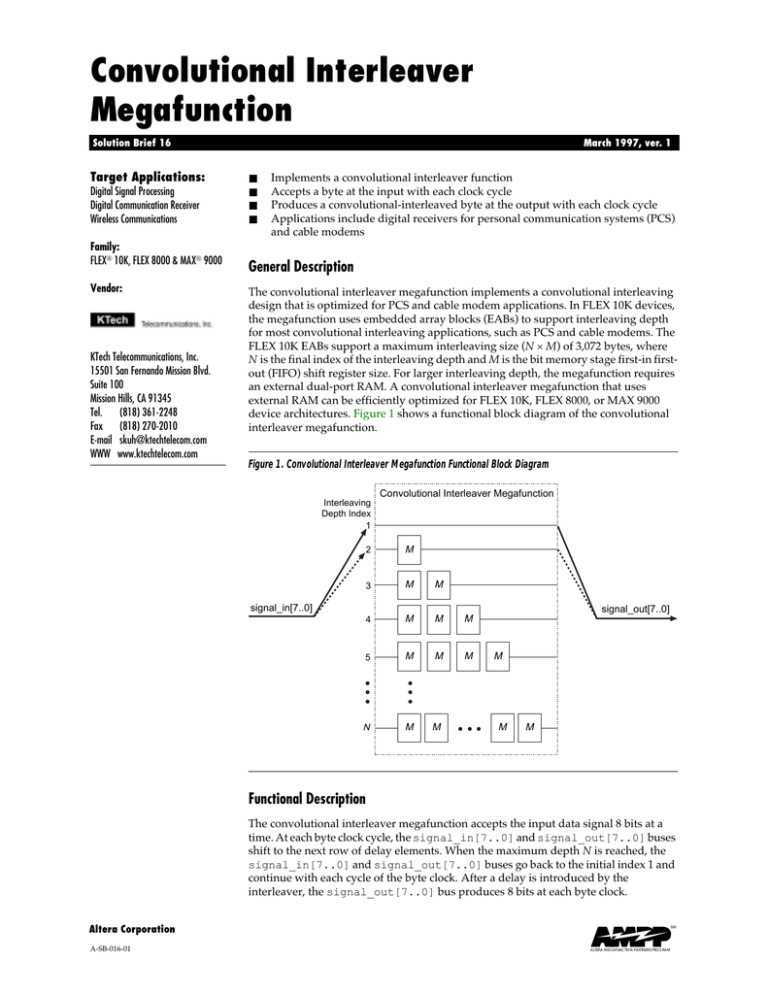
Convolutional Interleaver
Megafunction
Solution Brief 16
Target Applications:
Digital Signal Processing
Digital Communication Receiver
Wireless Communications
Family:
FLEX® 10K, FLEX 8000 & MAX® 9000
Vendor:
KTech Telecommunications, Inc.
15501 San Fernando Mission Blvd.
Suite 100
Mission Hills, CA 91345
Tel.
(818) 361-2248
Fax (818) 270-2010
E-mail skuh@ktechtelecom.com
WWW www.ktechtelecom.com
March 1997, ver. 1
■
■
■
■
Implements a convolutional interleaver function
Accepts a byte at the input with each clock cycle
Produces a convolutional-interleaved byte at the output with each clock cycle
Applications include digital receivers for personal communication systems (PCS)
and cable modems
General Description
The convolutional interleaver megafunction implements a convolutional interleaving
design that is optimized for PCS and cable modem applications. In FLEX 10K devices,
the megafunction uses embedded array blocks (EABs) to support interleaving depth
for most convolutional interleaving applications, such as PCS and cable modems. The
FLEX 10K EABs support a maximum interleaving size (N × M) of 3,072 bytes, where
N is the final index of the interleaving depth and M is the bit memory stage first-in firstout (FIFO) shift register size. For larger interleaving depth, the megafunction requires
an external dual-port RAM. A convolutional interleaver megafunction that uses
external RAM can be efficiently optimized for FLEX 10K, FLEX 8000, or MAX 9000
device architectures. Figure 1 shows a functional block diagram of the convolutional
interleaver megafunction.
Figure 1. Convolutional Interleaver Megafunction Functional Block Diagram
Convolutional Interleaver Megafunction
Interleaving
Depth Index
1
2
M
3
M
M
4
M
M
M
5
M
M
M
N
M
M
signal_in[7..0]
signal_out[7..0]
M
M
M
Functional Description
The convolutional interleaver megafunction accepts the input data signal 8 bits at a
time. At each byte clock cycle, the signal_in[7..0] and signal_out[7..0] buses
shift to the next row of delay elements. When the maximum depth N is reached, the
signal_in[7..0] and signal_out[7..0] buses go back to the initial index 1 and
continue with each cycle of the byte clock. After a delay is introduced by the
interleaver, the signal_out[7..0] bus produces 8 bits at each byte clock.
Altera Corporation
A-SB-016-01
SM
ALTERA MEGAFUNCTION PARTNERS PROGRAM
SB 16: Convolutional Interleaver Megafunction
Ports
Table 1 describes the ports for the convolutional interleaver megafunction.
Table 1. Convolutional Interleaver Megafunction Ports
Name
Type
Size (Bits)
Description
signal_in[7..0]
Input
8
Signal data input
byteclk
Input
–
Byte clock
reset
Input
–
Asynchronous global reset
signal_out[7..0]
Output
8
Signal data output
Parameters
The three EABs in the EPF10K10 device can hold a maximum of 768 bytes. Larger
FLEX 10K devices or external memory can support larger interleaving dimensions
(e.g., the EPF10K100 can support a maximum of 3,072 bytes). KTech
Telecommunications can customize the megafunction’s interleaving depth and bit
memory stage FIFO shift register size to meet specific user requirements.
Performance & Implementation
The convolutional interleaver megafunction operates at the byte clock rate. The
megafunction performance ranges from 52 MHz in FLEX 10K devices to 85 MHz in
MAX 9000 devices. Table 2 shows the performance and density information for a
typical convolutional interleaver megafunction in FLEX and MAX device architectures.
A downstream path in a quadrature phase shift keying (QPSK) cable modem requires
an interleaving size of N × M = 11 × 10. In this implementation, the megafunction’s
memory structure can easily fit into a single FLEX 10K EAB, or it can be expanded to
use all of the device’s EABs. The MAX 9000 implementation requires external memory.
Table 2. Performance & Implementation of the Convolutional Interleaver Megafunction
Device Family
Smallest Target
Device
Speed
Grade
Logic
Cells
EABs
Performance
(fMAX)
Maximum Interleaving
Size of Target Device
(N × M)
FLEX 10K
EPF10K10
-4
252
3
52 MHz
768 bytes
FLEX 8000
EPF8452A
A-2
244
–
66 MHz
–
MAX 9000
EPM9320
-12
185
–
85 MHz
–
®
2610 Orchard Parkway
San Jose, CA 95134-2020
(408) 894-7000
http://www.altera.com
2
Copyright 1997 Altera Corporation. Altera, AMPP, FLEX, FLEX 10K, FLEX 8000, MAX, MAX 9000, EPF10K10, EPF10K100, EPF8452A, and
EPM9320 are trademarks and/or service marks of Altera Corporation in the United States and other countries. Other brands or products are
trademarks of their respective holders. The specifications contained herein are subject to change without notice. Altera assumes no
responsibility or liability arising out of the application or use of any information, product, or service described herein except as expressly
agreed to in writing by Altera Corporation. Altera customers are advised to obtain the latest version of device specifications before relying on
any published information and before placing orders for products or services. All rights reserved.
Altera Corporation





